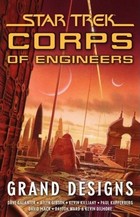 |
Mass market paperback, 482 pages Published 2007 Acquired and read November 2007 |
Star Wars: Republic Commando: True Colors
by Karen Traviss
The Republic Commando series continues from strength to strength-- I thought the first volume, Hard Contact, was all right, but the second, Triple Zero, was excellent, and though this one is not quite as good as that, it is by no means bad. It's less focused than the second book, gathering in a number of characters in unrelated situations across the galaxy, which is its biggest flaw, but it does have more rocking commando action. As always, Traviss's biggest strength is the ability to get inside the heads of her characters. The viewpoint of each one is strong and distinct, almost overpoweringly so-- you find yourself believing whatever the viewpoint character believes quite often. It's a different perspective than most other novels-- focusing on Jedi characters-- give us on the Clone Wars, and it's a welcome one, too. These are a group of clones with a little more awareness of their plight, and that raises some intriguing questions about the morality of the Clone Wars.
I look forward to the further of adventures of Delta Squad, Omega Squad, the Nulls, and the Cuy'val Dar in Order 66, though I'm bummed out that that has to be a hardcover. I really must pick up Traviss's original sf someday.
I look forward to the further of adventures of Delta Squad, Omega Squad, the Nulls, and the Cuy'val Dar in Order 66, though I'm bummed out that that has to be a hardcover. I really must pick up Traviss's original sf someday.














